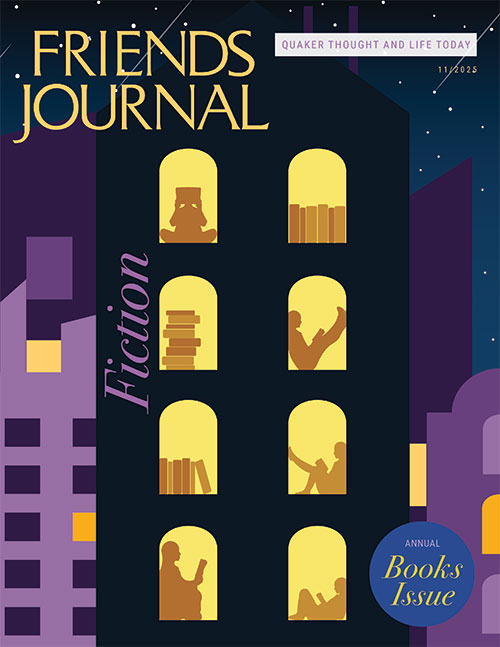An Interview with Chuck Wendig

In the 2023 horror novel Black River Orchard, American author Chuck Wendig writes about an addictive variety of apple that at first vivifies but then morally corrupts and destroys those who eat it. The book centers around characters in a fictional Pennsylvania town, including a widower who is raising his teenage daughter; a married lesbian couple; and a Quaker former military member, named John Compass. In addition to writing novels, which include the trilogy Star Wars: Aftermath, Wendig has penned Marvel comic books, such as the Hyperion series and Star Wars: The Force Awakens. Friends Journal talked with Wendig about creating Compass and other characters, horror writing, and his fascination with apples.
Sharlee DiMenichi: What initially interested you in creating a Quaker character?
Chuck Wendig: Not only am I obviously here in Pennsylvania and kind of in the heart of Quakerism, but I grew up with friends who were Quakers. We sent our son to a Quaker school. I just like everything that’s on offer with the Quakers, all things considered. The book that has the character is set in this area, so it felt like an appropriate thing. I had resources to touch on and people to talk to, so it felt like the right kind of character.
SD: When we first meet John Compass, he disarms a would-be shooter and declares that his heart is full of peace. But later, he employs his military training in a fight against evil. Could you talk a bit about his ethical outlook? Is that an evolution, or is that something that was always there for him?
CW: I think the evolution is a confusing one, because he didn’t start that way. He didn’t start Quaker; he started military. I think that being a Quaker pushed him to push all that military training aside. At the same time, there’s something in him that’s tough and tough to deal with. It’s something that’s trying to get uncaged and come out. It takes everything the character has to keep that in check, because of the way he was trained and because of who he was. He is trying to find that level of peace and redemption in later life after a sort of a rough go of things.
SD: How did the characters of Emily and Meg develop over the course of creating them?
CW: Just like any character does really. You write these people out, and you try to figure out who they are and what their journey could look like. I never want to decide upfront for sure how they’re going to end up. I like to follow that by instinct. As much as sometimes you do or don’t outline with characters, you really have to feel them out as they go and find those pivot points where they shift and change. And seeing these two characters, I knew they were going to have first parallel development but really don’t belong in parallel development, and so eventually it’s going to be a perpendicular thing, as they go against each other. So just making sure that that felt true to the characters as they developed, and, of course, tweaking in edits is always key.
SD: What appeals to you about writing horror as opposed to other genres?
CW: I always found horror to be comforting, and I continue to feel that way now. Everything I’ve written, even when it’s not a horror thing, usually has some expression of horror in it for me.
SD: I am intrigued by the idea of horror being comforting.
CW: Horror is comforting for a lot of reasons. First, it’s kind of fun, in a horrible way. Second, it confronts you with horrors that are almost certainly worse than the ones you’re experiencing in real life but also shows you characters who are grappling with those horrors. Third, I think it lets you contextualize scary stuff and anxiety in a safe space. I’m wont to compare it to how a sorcerer of the occult might summon a demon into a salt-and-chalk circle in order to control it. The book, the story, is the salt-chalk circle. It brings our anxieties to bear in a safe place to interrogate them—or do battle with them.
SD: What does body horror allow you to explore or convey that other types of horror writing do not?
CW: Any horror has a sort of existential vibe to it. Who are we? Are we going to make it? Are we going to be okay? And are we going to live? There is something truly visceral about body horror that gets down to that whole illness thing and of transformation. It really digs deep. When you look online, you’ll see a lot of stuff popping up on TikTok or Instagram. You might see an image of something on skin that just looks wrong. Suddenly you’re thinking that you don’t really want to see whatever this is. And I think that getting to that is a more physical, visceral horror, but it still speaks to that sense of transformation and who we are, a fear of who we are, of who we could become, and what happens with the dissolution of flesh. But then also on a basic level, it’s really just good horror. It’s like you can really freak people out: that sort of thing. And you know, I definitely got emails about some of the body horror in that book, for sure.

SD: How long did you spend researching Black River Orchard, and how long did it take to write?
CW: I didn’t spend too long researching it. I’m a lazy writer, which is to say somewhat opportunistic. I have long been interested in apples, something that I had researched just on my own, not for a book. It was just a thing that was interesting to me. When I become super interested in something, it becomes something that then I later question: Was there a book here? Is there something? Is there a story? So I work less from an idea that I then research; it’s more that I build up all this research and then think, Well, there’s a story in here somewhere. The research that then gets done specifically for the book is more like niche, local things that aren’t necessarily a long-standing body of research. The research is already there, and what you’re seeing in the book is just the tip of that particular iceberg.
For the writing, I usually take about six months on a first draft.
SD: What is a typical writing day like for you?
CW: Get up and get the kid off to school, with breakfast and so forth. Then I try to write. I used to write maybe around 2,000 words a day. Now I allow it to be a little more variable. So it can be 1,000 words or 1,500 words; sometimes it’s 3,000 words. It just depends on what that day looks like. I’m usually writing until midday-ish, early afternoon-ish. And then I do administrative stuff: calls like this, emails I have to answer, contracts I have to sign, or whatever else is going on.

SD: Do you write one book at a time or several simultaneously?
CW: Oh, one at a time. My brain does not hold two books at one time very easily. Back when I was doing comics, I was able to do a book in the morning and a comic in the afternoon: they seem to flex two different muscles. But in terms of actual writing, I can only write one at a time, and ultimately, currently, my contract demands that I write only one at a time. So if I am writing two at a time, I’m probably doing too much.
SD: Which characters in the book most closely express your own view of the nature of good and evil?
CW: I don’t know that any character really aptly mirrors me. It’s very difficult at the end of the day to write characters who aren’t at least a little bit like you. Empathy is very important in writing characters and trying to imagine what other people’s shoes are like, and then walking as many weird miles in those shoes as possible. At the end of the day, I can never really escape my own experiences and my own feelings, and then reflecting them, distorting them, and bending them backwards to see what they look like from different angles.






Comments on Friendsjournal.org may be used in the Forum of the print magazine and may be edited for length and clarity.